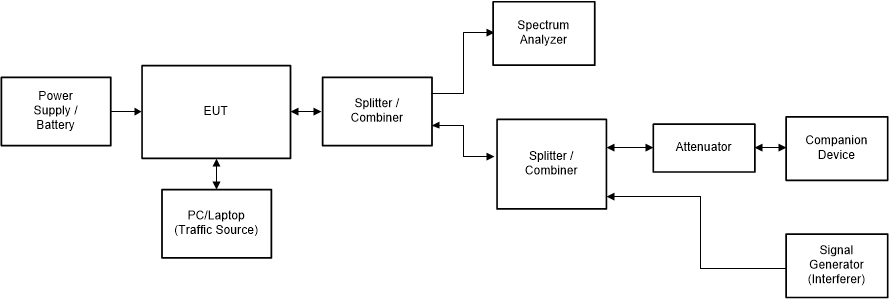SWRA681 September 2020 CC3100 , CC3100MOD , CC3120 , CC3120MOD , CC3135 , CC3135MOD , CC3200 , CC3200MOD , CC3220MOD , CC3220MODA , CC3220R , CC3220S , CC3220SF , CC3235MODAS , CC3235MODASF , CC3235MODS , CC3235MODSF , CC3235S , CC3235SF
- Abstract
- Trademarks
- 1Introduction
- 2CE Conformity Test Requirements and Test Procedure for Wi-Fi Devices
-
3Test Procedure for Compliance Testing - EN
300 328
- 3.1 Product Information as per Annex-E of EN 300 328
- 3.2 RF Output Power - EN 300 328
- 3.3 Power Spectral Density - EN 300 328
- 3.4 Occupied Channel Bandwidth (OCBW) - EN 300 328
- 3.5 Transmitter Unwanted Emissions in the OOB Domain - EN 300 328
- 3.6 Transmitter Unwanted Emissions in the Spurious Domain - EN 300 328
- 3.7 Adaptivity (Channel Access Mechanism) - EN 300 328
- 3.8 Receiver Spurious Emissions - EN 300 328
- 3.9 Receiver Blocking - EN 300 328
-
4Test Procedure for Compliance Testing for
Wi-Fi Devices - EN 301 893
- 4.1 Product Information as per Annex-G of EN 301 893
- 4.2 Test Channels - EN 301 893
- 4.3 Nominal Center Frequencies - EN 301 893
- 4.4 Occupied Channel Bandwidth (OCBW) - EN 301 893
- 4.5 RF Output Power - EN 301 893
- 4.6 Power Spectral Density - EN 301 893
- 4.7 Tx Unwanted Emissions Outside the 5 GHz RLAN Band - EN 301 893
- 4.8 Tx Unwanted Emissions Within the 5 GHz RLAN Bands - EN 301 893
- 4.9 Receiver Spurious Emissions - EN 301 893
- 4.10 Receiver Blocking - EN 301 893
- 4.11 Adaptivity (Channel Access Mechanism) - EN 301 893
- 4.12 Dynamic Frequency Selection (DFS) - EN 301 893
- 4.13 User Access Restrictions - EN 301 893
- 5Test Procedure for Compliance Testing for Wi-Fi Devices - EN 301 489
- 6Test Procedure for Compliance Testing for Wi-Fi Devices – IEC 62368-1
- 7Test Assessment for Human Exposure Restrictions – EN 62311
- 8References
3.7 Adaptivity (Channel Access Mechanism) - EN 300 328
The measurements for Adaptivity are performed at normal environmental conditions only. The measurement is performed on two operating frequencies randomly selected from the operating frequencies used by the EUT. The first (lower) frequency is randomly selected within the range 2400 MHz to 2442 MHz while the second (higher) frequency is randomly selected within the range 2442 MHz to 2483.5 MHz. The equipment is in a normal operating mode. The equipment is configured in a mode that results in the longest Channel Occupancy Time. The test setup for Adaptivity is shown in Figure 3-1. The test results comply with the requirements and limits shown in the Adaptive Non-FHSS Using DAA and Adaptive Non-FHSS - Short Control Signaling Transmissions sections in CE Regulations for SRDs Operating in License-Free 2.4 GHz/5 GHz Bands [1] and are recorded in the test report. The test procedure for Adaptivity measurements is described in the following steps:
 Figure 3-1 Test Setup for Adaptivity Testing
– EN 300 328
Figure 3-1 Test Setup for Adaptivity Testing
– EN 300 328- Make the test setup as shown in Figure 3-1.
- Switch ON the EUT and other test equipment.
- For detailed test procedure, see clause 5.4.6.2.1.3 of EN 300 328 [3].
- Configure AP to the desired mode and channel using AP configuration tool.
- Use the CPERF Testing Tool from TI [16] to setup and configure the EUT. For setting and up configuring the EUT, see the CPERF Testing Tool instructions [16].
- Carry out the tests as per clause 5.4.6.2.1.3 of EN 300 328 [3] test procedure.
- Repeat the above for other data rates/modulations and also other desired channels.
- The Adaptivity test results comply with the requirements and limits shown in the Adaptivity (Non-FHSS) section in CE Regulations for SRDs Operating in License-Free 2.4 GHz/5 GHz Bands [1] for all the test cases.